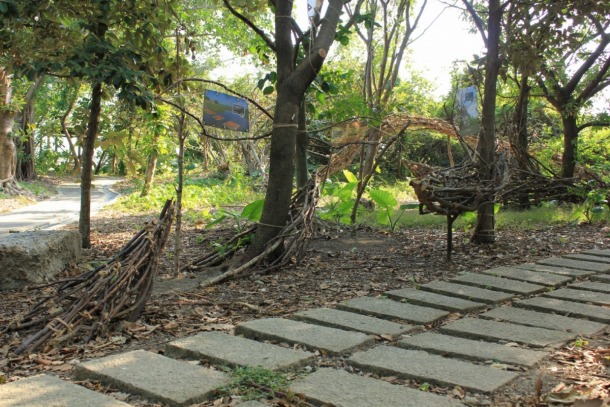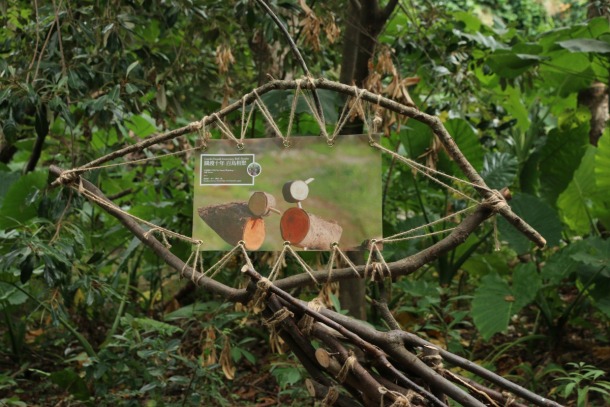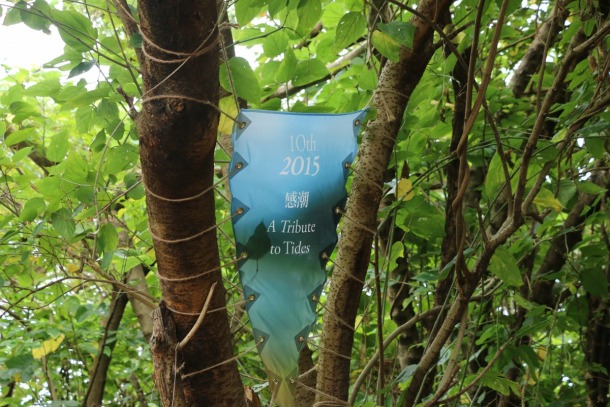 關渡國際自然裝置藝術季:十年回顧
關渡國際自然裝置藝術季:十年回顧
2006至2015年,25國59位藝術家在十屆的藝術季中完成了共70件作品。2015年11月,我們特地邀請藝術家李蕢至、連同蔣沛志與林章信共同創作此回顧展。誠摯歡迎您走入藝術季十年的時光隧道,細細感受在城市中的自然藝術脈動。
From 2006 to 2015, Guandu International Outdoor Sculpture Festival has invited 59 artists from 25 countries around the world to accomplish 70 pieces of artwork. To celebrate, we invite artist Kuei-Chih Lee with the help of Pei-Zhi Chiang and Chang-Hsin Lin to create this retrospective exhibition. We sincerely welcome you to take a tour through the time-tunnel exhibit featuring a display of all the pictures of past artworks.

設計概念
《潮語2_回看》Tide Whisper 2: Looking Back
創作者:李蕢至
聯合創作:蔣沛志、林章信
材質:樹枝、藤、麻繩、竹
年份:2015
地點:關渡自然公園_海岸林區
Artist: Lee, Kuei-Chih
Co-create: Chiang, Pei-Zhi; Lin, Chang-Hsin
Materials: Branches, rattan, hemp ropes, bamboo
Year: 2015
Location: Coastal Forest, Guandu Nature Park
一艘艘從土裡緩緩上升的船隻漂浮在關渡自然公園的土地上,航行的軌跡彎出一道自然與藝術相互交織的弧度,也是關渡國際自然裝置藝術季十週年的回顧。
這件作品位於公園內少被關注的區域,以自然裝置的形式結合現有風景重新置入一個不同的使用方式與另一種觀看的視角與路徑。它是動植物的棲地,也隨著時間變化的有機雕塑。我的概念是藉由水來連結流動的時間性,透過船的意象符號詮釋空間運動的存有,並呼應著上一屆藝術季主題「感潮」。
在時空的洄瀾更迭中,由樹枝集合構成的船隻和藤編鳥巢是鳥的生物記憶,像是承載著一段段故事的搖籃,牽引著過去作品的圖像回看與航行。鳥類雕塑結合關渡自然公園每年調查的鳥類數據。從2005~2014十年的調查數據中,挑選出十種數量消長較顯著鳥類。回應關渡自然公園對於濕地鳥類棲息環境的保育工作和這十年來的消長與環境變化,並試著在物理世界中讓抽象的思維具體。
李蕢至
十年鳥類消長數據,反映關渡自然環境的變化,甚或透出全球環境變遷的訊息。
作品中舉出了十種由關渡自然公園棲地保育所進行的穿越線調查最近的十年紀錄中,數量變化較大的鳥種。需要茂林的綠繡眼、白頭翁、紅嘴黑鵯、金背鳩等的數量增加,說明關渡自然公園育樹成林的結果;冬候鳥的小水鴨、黑臉鵐數量的銳減,加上琵鷺持續的紀錄,這些在北半球冬日不再遷移到更溫暖南方度冬的鳥兒,正在提醒著我們全球暖化的現象確實存在;逸出的埃及聖䴉、遷徒性的高蹺鴴持續穩定的增加,說明關渡濕地提供優質環境,使這些外客做出於此定居並繁洐後代的決定;常見於水田環境的鷹斑鷸,是較受人為活動影響的物種,相較於其他鷸科在關渡調查記錄的變化,隱約透著在關渡這片土地上,人類過度干擾的警訊。
環境的變化,左右著鳥類的生態,同屬這個環境成員的你我,何嘗不是如此?這正是「今日鳥類,明日人類」的最佳寫照。
蔣沛志
關渡國際自然裝置藝術十年來許多作品都是由藝術家與推手一起完成的,入口意象的創作概念即是藉由中心點向外輻射的線條,象徵來自社會各界的扶持,以及眾人共同守護藝術季的終極關懷。
林章信
The boats rise out of the soil slowly and one by one float above the land of Guandu Nature Park. The course taken by these boats meander and intertwine nature with art. This is also a ten-year look back on the Guandu International Outdoor Sculpture Festival.
This artwork is located at an area which is less frequented by visitors. The artwork hopes to combine natural art installations into the current landscape, in order to draw visitors to view this area with a new perspective. The artwork is a habitat for plants and animals, as well as an organic sculpture that will change over time. My idea is to connect the flow temporality with the concept of water by using boats as symbols of space movement and responding to the tenth Festival’s theme “A Tribute to Tides”.
The boats assembled with tree branches and the nests made from rattan can be regarded as birds’ biological memories in the change of time and space. They are like cradles carrying with different stories, which lead us through the pictures of past artworks. The bird sculptures combine the annual results of the bird survey conducted by Guandu Nature Park. From the bird survey between 2005 to 2014, ten species of birds whose number have been found to fluctuate significantly over time were selected. The bird sculptures represent Guandu Nature Park's effort in wetland habitat conservation and the environment, where this change in wildlife population over a decade are taken from the abstract and presented physically.
Lee, Kuei-Chih
The growth and decline of bird population in past ten years reflect environmental change at Guandu, and as well as on a global level.
The artwork used the latest 10-year record from line transect bird survey done by Guandu Nature Park and chose ten species whose changes in numbers were more pronounced. The increase of the birds that prefer dense forest, includes Japanese white-eye, Chinese bulbul, Black bulbul, Oriental turtle dove, tells the effort of Guandu Nature Park to reforest areas to provide cover for birds. The huge decline of winter migratory birds such as the Common teal, Black-faced bunting, and the constant appearance of Eurasian spoonbill, suggests these migrants maybe stopping flying south for the winter as a result of global warming. The population increase in some birds such as the non-native African sacred ibis or the once migratory Black-winged stilt, suggests that Guandu wetland has become a great place to live and breed. On the other hand, the changes in numbers of Wood sandpiper which is usually considered to be more easily affected by human activities, when compared to other sandpipers, can be regarded as a warning of increase in human impact on the environment in the Guandu area.
Environmental changes impact birds and human beings as well. You and I, we are all part of this environment. Today birds, tomorrow human.
Chiang, Pei-Zhi
Many of the artworks in the Guandu International Outdoor Sculpture Festival are actually collaborative efforts between artists and volunteers. My idea for this entrance installation is to create lines radiating from the center and outward, to symbolize all the support from communities, groups and individuals. This entrance also represents the care people have given to working together to create and make this event possible.
Lin, Chang-Hsin
|
鳥種 |
94 |
95 |
96 |
97 |
98 |
99 |
100 |
101 |
102 |
103 |
|---|---|---|---|---|---|---|---|---|---|---|
|
小水鴨 |
4201 |
2187 |
3500 |
1683 |
933 |
1562 |
1291 |
1348 |
736 |
767 |
|
白琵鷺 |
0 |
0 |
0 |
2 |
2 |
3 |
4 |
4 |
3 |
8 |
|
埃及聖鹮 |
50 |
108 |
395 |
151 |
107 |
457 |
192 |
209 |
158 |
140 |
|
高蹺鴴 |
27 |
324 |
66 |
118 |
230 |
300 |
673 |
313 |
437 |
522 |
|
鷹斑鷸 |
184 |
52 |
131 |
93 |
264 |
581 |
186 |
217 |
69 |
51 |
|
金背鳩 |
25 |
25 |
19 |
46 |
104 |
99 |
90 |
52 |
107 |
65 |
|
紅嘴黑鵯 |
2 |
2 |
10 |
3 |
10 |
7 |
14 |
11 |
8 |
6 |
|
白頭翁 |
43 |
133 |
94 |
123 |
134 |
135 |
60 |
84 |
75 |
157 |
|
綠繡眼 |
54 |
50 |
35 |
30 |
222 |
124 |
150 |
84 |
146 |
172 |
|
黑臉鵐 |
106 |
51 |
53 |
16 |
62 |
30 |
16 |
14 |
27 |
23 |




